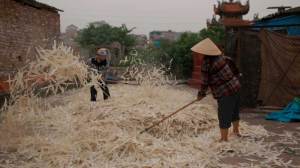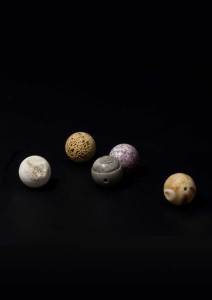As the Wellcome Collection undergoes a £17.5million development project to increase gallery space and event capacity, their latest exhibition – ‘Foreign Bodies, Common Ground’ – takes an unusually self-reflexive position, looking beyond the sometimes cosy world of art-science collaboration towards a relationship underpinned by a certain productive friction.
Founded by Sir Henry Wellcome in 1936, the Wellcome Trust has an endowment of around £14.5billion, making it one of the largest providers of funding for scientific research in the world (after the Bill & Melinda Gates Foundation). Every year, the Trust also hands out approximately £3million to the arts, under the remit of Public Engagement. This may be a very small percentage of the Trust’s overall expenditure, but in a landscape of public funding cuts, it’s extremely significant.
Interestingly, ‘Foreign Bodies, Common Ground’ frames itself in direct response to the Trust’s financial clout. Taking place in the low-ceilinged spaces of the fifth floor (whilst building work continues downstairs) the exhibition begins with a series of simple penned notes by artists Miriam Syowia Kyambi and James Muriuki: ‘Understanding vs Trust’ or ‘Science cannot give absolute answers’. Most telling of all perhaps, the single word: ‘Funding’.

Where birds dance their last (2012), Lena Bui, courtesy Lena Bui
It’s a bold way to contextualise a show that consists of material from six separate projects, all funded by the Trust as part of the Art in Global Health residency programme in 2012–13. For each project, curator Danielle Olsen paired an artist with a Trust-funded research centre – in Kenya, Malawi, South Africa, Thailand, Vietnam and the UK – as part of Wellcome’s ‘desire to engage the curious public globally’.
I’ve written in more detail elsewhere about the problems of reducing art to a tool for science communication or public engagement, but what arises from this show is the more troubling spectre of colonialism. Where once colonial explorers toured the world in crisp white suits and pith helmets, today power and wealth arrive within the sterilised confines of a scientific research centre, clad in the pristine white of the lab coat.
This is explored in the work of Kyambi and Muriuki, working collaboratively during their residency at the KEMRI-Wellcome Trust Research programme in Kilifi, Kenya. Pata Picha photography studio consists of a photographic set made up of artefacts from various different lifestyles or belief systems (glitzy red curtains; Debby Classique fashion magazine; laminate tile-effect flooring; a microscope) placed together in a fictional interior. Visitors are encouraged to don white lab coats (customised with gold and vibrant patterned cloth) and pose as scientists themselves.
This work draws attention to the first half of the title – Foreign Bodies. As Olsen notes in her introduction to the beautiful publication that accompanies the show: ‘the majority of medical researchers are often “foreigners” in relation to the communities that they work with’. Equally, ‘during their encounters in the realms of medical science, the artists were outsiders’ too. Hence also Common Ground.

Fossil Necklace Credit (2013), Katie Paterson © MJC, courtesy the artist
Elsewhere, the exhibition showcases Elson Kambalu’s paintings and sculptures collaboratively produced with women and children in Malawi; documentation of B-Floor Theatre’s performance in Thailand; Katie Paterson’s Fossil Necklace (like tiny worlds charted, then strung together and lit up in soft dramatic glow); and Lena Bui’s work across drawing, photography, sculpture and sumptuous video, exploring the relationship between humans and animals – in particular, zoonosis, the transfer of diseases across species. Her work in some ways explores the limits of science, and the disastrous effects of seeing other species as inferiors to subjugate and exploit.
In New Atlantis, his utopian novel of 1624, Francis Bacon envisions a future scientific institution whose founder famously declares: ‘The end of our foundation is the knowledge of causes, and secret motions of things; and the enlarging of the bounds of human empire, to the effecting of all things possible.’ This association between science and power, knowledge and the exploitation of others (races, species) has been with us since the Enlightenment, and is still as complex and problematic as ever. It takes a brave, multi-faceted and thought-provoking exhibition like ‘Foreign Bodies, Common Ground’ to bring this to the foreground once more.
‘Foreign Bodies, Common Ground’ is at the Wellcome Collection, London until 16 March 2014.

Wellcome Questions
Pata Picha Studio (2013), Miriam Syowia Kyambi and James Muriuki, courtesy Wellcome Images
Share
As the Wellcome Collection undergoes a £17.5million development project to increase gallery space and event capacity, their latest exhibition – ‘Foreign Bodies, Common Ground’ – takes an unusually self-reflexive position, looking beyond the sometimes cosy world of art-science collaboration towards a relationship underpinned by a certain productive friction.
Founded by Sir Henry Wellcome in 1936, the Wellcome Trust has an endowment of around £14.5billion, making it one of the largest providers of funding for scientific research in the world (after the Bill & Melinda Gates Foundation). Every year, the Trust also hands out approximately £3million to the arts, under the remit of Public Engagement. This may be a very small percentage of the Trust’s overall expenditure, but in a landscape of public funding cuts, it’s extremely significant.
Interestingly, ‘Foreign Bodies, Common Ground’ frames itself in direct response to the Trust’s financial clout. Taking place in the low-ceilinged spaces of the fifth floor (whilst building work continues downstairs) the exhibition begins with a series of simple penned notes by artists Miriam Syowia Kyambi and James Muriuki: ‘Understanding vs Trust’ or ‘Science cannot give absolute answers’. Most telling of all perhaps, the single word: ‘Funding’.
Where birds dance their last (2012), Lena Bui, courtesy Lena Bui
It’s a bold way to contextualise a show that consists of material from six separate projects, all funded by the Trust as part of the Art in Global Health residency programme in 2012–13. For each project, curator Danielle Olsen paired an artist with a Trust-funded research centre – in Kenya, Malawi, South Africa, Thailand, Vietnam and the UK – as part of Wellcome’s ‘desire to engage the curious public globally’.
I’ve written in more detail elsewhere about the problems of reducing art to a tool for science communication or public engagement, but what arises from this show is the more troubling spectre of colonialism. Where once colonial explorers toured the world in crisp white suits and pith helmets, today power and wealth arrive within the sterilised confines of a scientific research centre, clad in the pristine white of the lab coat.
This is explored in the work of Kyambi and Muriuki, working collaboratively during their residency at the KEMRI-Wellcome Trust Research programme in Kilifi, Kenya. Pata Picha photography studio consists of a photographic set made up of artefacts from various different lifestyles or belief systems (glitzy red curtains; Debby Classique fashion magazine; laminate tile-effect flooring; a microscope) placed together in a fictional interior. Visitors are encouraged to don white lab coats (customised with gold and vibrant patterned cloth) and pose as scientists themselves.
This work draws attention to the first half of the title – Foreign Bodies. As Olsen notes in her introduction to the beautiful publication that accompanies the show: ‘the majority of medical researchers are often “foreigners” in relation to the communities that they work with’. Equally, ‘during their encounters in the realms of medical science, the artists were outsiders’ too. Hence also Common Ground.
Fossil Necklace Credit (2013), Katie Paterson © MJC, courtesy the artist
Elsewhere, the exhibition showcases Elson Kambalu’s paintings and sculptures collaboratively produced with women and children in Malawi; documentation of B-Floor Theatre’s performance in Thailand; Katie Paterson’s Fossil Necklace (like tiny worlds charted, then strung together and lit up in soft dramatic glow); and Lena Bui’s work across drawing, photography, sculpture and sumptuous video, exploring the relationship between humans and animals – in particular, zoonosis, the transfer of diseases across species. Her work in some ways explores the limits of science, and the disastrous effects of seeing other species as inferiors to subjugate and exploit.
In New Atlantis, his utopian novel of 1624, Francis Bacon envisions a future scientific institution whose founder famously declares: ‘The end of our foundation is the knowledge of causes, and secret motions of things; and the enlarging of the bounds of human empire, to the effecting of all things possible.’ This association between science and power, knowledge and the exploitation of others (races, species) has been with us since the Enlightenment, and is still as complex and problematic as ever. It takes a brave, multi-faceted and thought-provoking exhibition like ‘Foreign Bodies, Common Ground’ to bring this to the foreground once more.
‘Foreign Bodies, Common Ground’ is at the Wellcome Collection, London until 16 March 2014.
Unlimited access from just $16 every 3 months
Subscribe to get unlimited and exclusive access to the top art stories, interviews and exhibition reviews.
Share
Recommended for you
Calling Time
‘The Show is Over’ at Gagosian Gallery, where painting’s elaborate deferrals of its death-scene extend like a multi-volume suicide note
Arch Enemies
There is no convincing moral argument against it: rebuild the Euston Arch!
Bubbles
Are steel balloons the new tulip paintings?